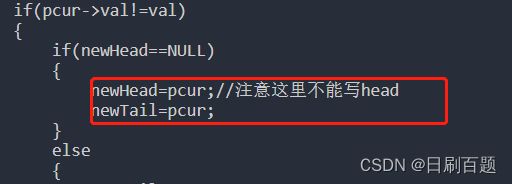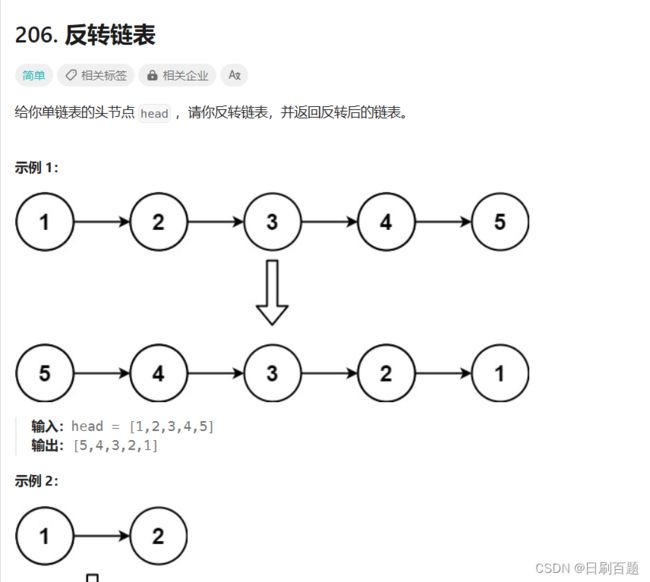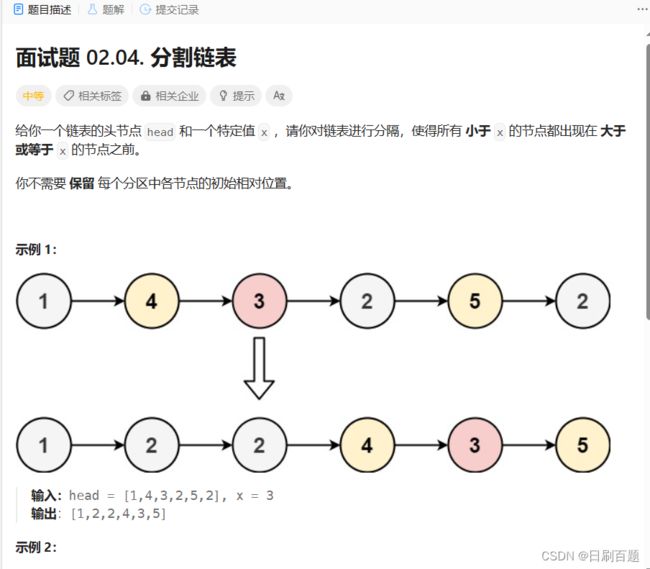C语言每日一练(二)
单链表经典算法专题
一、 单链表相关经典算法OJ题1:移除链表元素
解法一:在原链表中删除Node.next=next的节点
typedef struct ListNode ListNode;
struct ListNode* removeElements( ListNode* head, int val) {
ListNode* pcur = head;
ListNode* pre = head;
while (pcur)
{
while (pcur->val != val )
{
pre = pcur;
pcur = pcur->next;
if (pcur == NULL)
{
return head;
}
}
if (head->val == val)
{
head = head->next;
pcur = head;
pre = head;
}
else if (pcur->val == val)
{
pcur = pcur->next;
pre->next = pcur;
}
}
return head;
}注意:当头节点的val==val时,要改变头节点的位置
解法二:创建新的指向头尾的链表
typedef struct ListNode ListNode;
struct ListNode* removeElements(struct ListNode* head, int val){
ListNode * newHead=NULL;
ListNode * newTail=NULL;
ListNode* pcur=head;
while(pcur)
{
if(pcur->val!=val)
{
if(newHead==NULL)
{
newHead=pcur;//注意这里不能写head
newTail=pcur;
}
else
{
newTail->next=pcur;
newTail=newTail->next;
}
}
pcur=pcur->next;
}
if(newTail)
{
newTail->next=NULL;
}
return newHead;
}注意:这里如果写head的话,当一个节点是要删除的节点,头节点还是那个删除的节点。
二、单链表相关经典算法OJ题2:反转链表
解法一:创建新链表,对新链表进行头插
typedef struct ListNode SLNode;
struct ListNode* reverseList(struct ListNode* head){
SLNode* newHead = NULL;
SLNode* newTail = NULL;
SLNode* pcur = head;
SLNode* last = head;
while (head!=NULL)
{
if (newHead == NULL)
{
newHead = newTail = head;
head = head->next;
}
else
{
last = head;
head = head->next;
pcur = last;
pcur->next = newHead;
newHead = pcur;
}
}
if (newTail!=NULL)
{
newTail->next = NULL;
}
return newHead;
}
解法二:定义三个变量,n1,n2,n3(n1,n2用来反转指向,n3在前面遍历)
typedef struct ListNode ListNode;
struct ListNode* reverseList( ListNode* head) {
if(head==NULL)
{
return NULL;
}
ListNode * n1=NULL;
ListNode * n2=head;
ListNode * n3=head->next;
while(n2)
{
n2->next=n1;
n1=n2;
n2=n3;
if(n3)
{
n3=n3->next;
}
}
return n1;
}三、 单链表相关经典算法OJ题3:合并两个有序链表
解法一:在原链表基础上进行修改,会使用到指定位置之前插入数
typedef struct ListNode ListNode;
struct ListNode* mergeTwoLists(struct ListNode* list1, struct ListNode* list2){
if (list1 == NULL)
{
return list2;
}
if (list2 == NULL)
{
return list1;
}
ListNode* pcur1 = list1;
ListNode* pre =list1;
ListNode* pcur2 = list2;
ListNode* pcur3 = list2->next;
while (pcur1 && pcur2)
{
while (pcur1->val < pcur2->val)
{
pre = pcur1;
pcur1 = pcur1->next;
if (pcur1 == NULL)
{
pre->next = pcur2;
return list1;
}
}
if (list1->val > pcur2->val)
{
pcur2->next = list1;
list1 = pcur2;
pre = list1;
pcur2 = pcur3;
if (pcur3 != NULL)
{
pcur3 = pcur3->next;
}
}
//在pur1实现头插
else
{
pre->next = pcur2;
pcur2->next = pcur1;
pcur2 = pcur3;
if (pcur3 != NULL)
{
pcur3 = pcur3->next;
}
}
}
return list1;
}输出结果:
解法二:创建一个新的空链表,遍历俩个链表,进行新链表的尾插
(使用单链表)无头单向不循环链表
typedef struct ListNode ListNode;
struct ListNode* mergeTwoLists(struct ListNode* list1, struct ListNode* list2){
if (list1 == NULL)
{
return list2;
}
if (list2 == NULL)
{
return list1;
}
ListNode* newhead=NULL;
ListNode* newtail=NULL;
ListNode* pcur1=list1;
ListNode* pcur2=list2;
while(pcur1&&pcur2)
{
if(pcur1->valval)
{
if(newhead==NULL)//插入新链表
{
newhead=newtail=pcur1;
}
else
{
newtail->next=pcur1;
newtail=newtail->next;
}
pcur1=pcur1->next;
}
else
{
if(newhead==NULL)//插入新链表
{
newhead=newtail=pcur2;
}
else
{
newtail->next=pcur2;
newtail=newtail->next;
}
pcur2=pcur2->next;
}
}
if(pcur1==NULL)
{
newtail->next=pcur2;
}
if(pcur2==NULL)
{
newtail->next=pcur1;
}
return newhead;
} 优化解法二(使用带头单向不循环链表)
typedef struct ListNode ListNode;
struct ListNode* mergeTwoLists(struct ListNode* list1, struct ListNode* list2){
if (list1 == NULL)
{
return list2;
}
if (list2 == NULL)
{
return list1;
}
ListNode* newhead,*newtail;
newhead= newtail=(ListNode*)malloc(sizeof(ListNode));
ListNode* pcur1=list1;
ListNode* pcur2=list2;
while(pcur1&&pcur2)
{
if(pcur1->valval)
{
//直接插入新链表
newtail->next=pcur1;
newtail=newtail->next;
pcur1=pcur1->next;
}
else
{
newtail->next=pcur2;
newtail=newtail->next;
pcur2=pcur2->next;
}
}
if(pcur1==NULL)
{
newtail->next=pcur2;
}
if(pcur2==NULL)
{
newtail->next=pcur1;
}
ListNode * rethead=newhead->next;
free(newhead);
newhead=NULL;
return rethead;;
} 注:相比较与不带头链表,带头链表省略了反复判断头节点是否为空,直接插入头的后面,所带的头不带任何数据,所以返回的时候,返回头的next.
四、单链表相关经典算法OJ题4:链表的中间结点
解法一:使用快慢指针
//快慢指针
typedef struct ListNode ListNode;
struct ListNode* middleNode(struct ListNode* head){
if(head==NULL)
{
return NULL;
}
ListNode * slow,*fast;
slow=head;
fast=head;
while(fast&&fast->next)
{
slow=slow->next;
fast=fast->next->next;
}
return slow;
}注:这种快慢指针可以运用到寻找单链表的倒数第几个节点,比如说,找倒数第3个节点,只需要让慢指针与快指针相差3个节点,当快指针走到NULL,此时慢指针为倒数第3个节点。
还有一点值得注意的是 while(fast&&fast->next)该位置判断不能颠倒,因为可能fast为空,此时先判断fast->next会报错。
五、 循环链表经典应⽤-环形链表的约瑟夫问题
著名的Josephus问题
据说著名犹太 历史学家 Josephus有过以下的故事:在罗⻢⼈占领乔塔帕特后,39 个犹太⼈与
Josephus及他的朋友躲到⼀个洞中,39个犹太⼈决定宁愿死也不要被⼈抓到,于是决定了⼀个⾃杀 ⽅式,41个⼈排成⼀个圆圈,由第1个⼈开始报数,每报数到第3⼈该⼈就必须⾃杀,然后再由下⼀ 个重新报数,直到所有⼈都⾃杀⾝亡为⽌。 然⽽Josephus 和他的朋友并不想遵从,Josephus要他的朋友先假装遵从,他将朋友与⾃⼰安排在第16个与第31个位置,于是逃过了这场死亡游戏。
解法一:创建一个单向循环链表,遇到计数等于m的节点删除,剩下最后一个节点的val值即为所求编号
typedef struct ListNode ListNode;
ListNode * SLbuyNode(int x)//创造一个节点
{
ListNode * Node=(ListNode*)malloc(sizeof(ListNode));
Node->val=x;
Node->next= NULL;
return Node;
}
//创建一个循环链表
ListNode *CreatSLNode(int n)
{
ListNode * head=SLbuyNode(1);
ListNode * tail=head;
for(int i=2;i<=n;i++)
{
tail->next=SLbuyNode(i);
tail=tail->next;
}
tail->next=head;
return tail;
}
int ysf(int n, int m ) {
ListNode* prev=CreatSLNode(n);
ListNode* pcur=prev->next;
int count=1;
while(pcur->next!=pcur)
{
if(count==m)//报到m的节点删除
{
prev->next=pcur->next;
free(pcur);
pcur=prev->next;
count=1;
}
else //没报m继续往前走
{
prev=pcur;
pcur=pcur->next;
count++;
}
}
return pcur->val;
}注意:红框若改成SLbuyNode(1),表示tail又重新开辟一块空间,和head不是同一片空间,所以连不起来。
六、 单链表相关经典算法OJ题5:分割链表
解法一:创建俩个带头单向不循环链表,将大于等于x和小于x的节点,分别放入俩个空链表,然后小链表和大链表头尾相接
typedef struct ListNode ListNode;
struct ListNode* partition(struct ListNode* head, int x){
if(head==NULL)
{
return NULL;
}
ListNode * maxhead,*maxtail;
ListNode * minhead,*mintail;
maxhead= maxtail=(ListNode*)malloc(sizeof(ListNode));
minhead=mintail=(ListNode*)malloc(sizeof(ListNode));
ListNode *pcur=head;
while(pcur)
{
if(pcur->valnext=pcur;
mintail=mintail->next;
pcur=pcur->next;
}
else
{
maxtail->next=pcur;
maxtail=maxtail->next;
pcur=pcur->next;
}
}
if(maxtail->next!=NULL)
{
maxtail->next=NULL;
}
mintail->next=maxhead->next;
ListNode*ret= minhead->next;
free(maxhead);
maxhead=NULL;
free(minhead);
minhead=NULL;
return ret;
}








